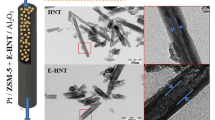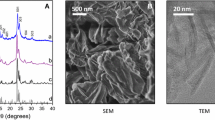Abstract
A methanol conversion catalyst based on natural aluminosilicate nanotubes and H–ZSM-5 zeolite was synthesized. Its textural, structural, and acid properties were studied by low-temperature nitrogen adsorption–desorption, transmission electron microscopy, X-ray diffraction analysis, and temperature-programmed ammonia desorption. The influence exerted on the methanol conversion and product distribution by the reaction temperature (380–460°С), pressure (0.1–0.5 MPa), and feed space velocity (0.5–1 h–1) was studied. The catalyst based on halloysite aluminosilicate nanotubes showed high selectivity in formation of both lower olefins and aromatic hydrocarbons.





Similar content being viewed by others
REFERENCES
Valecillos, J., Epelde, E., Albo, J., Aguayo, A.T., Bilbao, J., and Castaño, P., Catal. Today, 2020, vol. 348, pp. 243–256. https://doi.org/10.1016/j.cattod.2019.07.059
Wang, C., Yang, M., Zhang, W., Su, X., Xu, S., Tian, P., and Liu, Z., RSC Adv., 2016, vol. 6, no. 53, pp. 47864–47872. https://doi.org/10.1039/C6RA06428K
Bleken, F., Skistad, W., Barbera, K., Kustova, M., Bordiga, S., and Beato, P., Phys. Chem. Chem. Phys., 2011, vol. 3, pp. 2539–2549. https://doi.org/10.1039/C0CP01982H
Jamil, A.K., Nishitoba, T., Ahmed, M.H.M., Yamani, Z.H., Yokoi, T., and Muraza, O., Energy Fuels, 2019, pp. 12679–12684. https://doi.org/10.1021/acs.energyfuels.9b03009
Yarulina, I., Wispelaere, De K., Bailleul, S., Goetze, J., Radersma, M., and Abou-Hamad, E., Nature Chem., 2018, vol. 10, pp. 804–812. https://doi.org/10.1038/s41557-018-0081-0
Xia, W., Wang, F., Mu, X., Chen, K., Takahashi, A., Nakamura, I., and Fujitani, T., Catal. Commun., 2017, vol. 91, pp. 62–66. https://doi.org/10.1016/j.catcom.2016.12.010
Khadzhiev, S.N., Kolesnichenko, N.V., and Ezhova, N.N., Petrol. Chem., 2008, vol. 48, no. 5, pp. 325–334. https://doi.org/10.1134/S0965544108050010
Rostamizadeh, M. and Yaripour, F., Fuel, 2016, vol. 181, pp. 537–546. https://doi.org/10.1016/j.fuel.2016.05.019
Losch, P., Laugel, G., Martinez-Espin, J.S., Chavan, S., Olsbye, U., and Louis, B., Top. Catal., 2015, vol. 58, nos. 14–17, pp. 826–832. https://doi.org/10.1007/s11244-015-0449-y
Meng, Y., Genuino, H.C., Kuo, C.-H., Huang, H., Chen, S.-Y., Zhang, L., and Suib, S.L., J. Am. Chem. Soc., 2013, vol. 135, no. 23, pp. 8594–8605. https://doi.org/10.1021/ja4013936
Mentzel, U.V., Højholt, K.T., Holm, M.S., Fehrmann, R., and Beato, P., Appl. Catal. A: General, 2012, vols. 417– 418, pp. 290–297. https://doi.org/10.1016/j.apcata.2012.01.003
Yang, Y., Sun, C., Du, J., Yue, Y., Hua, W., Zhang, C., and Xu, H., Catal. Commun., 2012, vol. 24, pp. 44–47. https://doi.org/10.1016/j.catcom.2012.03.013
Afokin, M.I., Smirnova, E.M., Starozhitskaya, A.V., Gushchin, P.A., Glotov, A.P., and Maksimov, A.L., Chem. Technol. Fuels Oils, 2020, vol. 55, pp. 682–688. https://doi.org/10.1007/s10553-020-01082-1
Glotov, A.P., Roldugina, E.A., Artemova, M.I., Smirnova, E.M., Demikhova, N.R., Stytsenko, V.D., Egazar’yants, S.V., Maksimov, A.L., and Vinokurov, V.A., Russ. J. Appl. Chem., 2018, vol. 91, no. 8, pp. 1353−1362. https://doi.org/10.1134/S1070427218080141
Vinokurov, V.A., Stavitskaya, A.V., Chudakov, Ya.A., Glotov, A.P., Ivanov, E.V., Gushchin, P.A., Lvov, Yu.M., Maximov, A.L., Muradov, A.V., and Karakhanov, E.A., Pure Appl. Chem., 2018, vol. 90, no. 5, pp. 825–832. https://doi.org/10.1515/pac-2017-0913
Vinokurov, V.A., Stavitskaya, A.V., Glotov, A.P., Novikov, A.A., Zolotukhina, A.V., Kotelev, M.S., Gushchin, P.A., Ivanov, E.V., Darrat, Y., and Lvov, Yu.M., J. Solid State Chem., 2018, vol. 268, pp. 182–189. https://doi.org/10.1016/j.jssc.2018.08.042
Lai, S.H., Meng, D., Zhan, W., Guo, Y., Guo, Y., Zhang, Z., and Lu, G., RSC Adv., 2015, vol. 5, pp. 90235–90244. https://doi.org/10.1039/C5RA12505G
Lin, B., Wang, J., Huang, Q., Ali, M., and Chi, Y., J. Anal. Appl. Pyrol., 2017, vol. 128, pp. 291–303. https://doi.org/10.1016/j.jaap.2017.09.021
Wu, X., Liu, C., Qi, H., Zhang, X., Dai, J., Zhang, Q., Zhang, L., Wu, Y., and Peng, X., Appl. Clay Sci., 2016, vol. 119, pp. 284–293. https://doi.org/10.1016/j.clay.2015.10.029
Roldugina, E.A., Glotov, A.P., Isakov, A.L., Maksimov, A.L., Vinokurov, V.A., and Karakhanov, E.A., Russ. J. Appl. Chem., 2019, vol. 92, pp. 1170−1178. https://doi.org/10.1134/S1070427219080172
Glotov, A.P., Roldugina, E.A., Artemova, M.I., Smirnova, E.M., Demikhova, N.R., Stytsenko, V.D., and Vinokurov, V.A., Russ. J. Appl. Chem., 2018, vol. 91, no. 8, pp. 1353–1362. https://doi.org/10.1134/S1070427218080141
Glotov, A.P., Stavitskaya, A.V., Chudakov, Y.A., Artemova, M.I., Smirnova, E.M., Demikhova, N.R., and Vinokurov, V.A., Petrol. Chem., 2018, vol. 58, pp. 1221–1226. https://doi.org/10.1134/S0965544118140013
Glotov, A.P., Artemova, M.I., Demikhova, N.R., Smirnova, E.M., Ivanov, E.V., Gushchin, P.A., and Vinokurov, V.A., Petrol. Сhem., 2019, vol. 59, pp. 1226–1234. https://doi.org/10.1134/S0965544119110033
Ni, Y., Sun, A., Wu, X., Hai, G., Hu, J., Li, T., and Li, G., J. Natural Gas Chem., 2011, vol. 20, no. 3, pp. 237–242. https://doi.org/10.1016/S1003-9953(10)60184-3
Golubev, K.B., Batova, T.I., Kolesnichenko, N.V., and Maximov, A.L., Catal. Commun., 2019, vol. 129, article 105744. https://doi.org/10.1016/j.catcom.2019.105744
Yang, Y., Sun, C., Du, J., Yue, Y., Hua, W., Zhang, C., and Xu, H., Catal. Commun., 2012, vol. 24, pp. 44–47. https://doi.org/10.1016/j.catcom.2012.03.013
Funding
The study was financially supported by the Russian Foundation for Basic Research (project no. 20-38-90269). Analysis of gaseous and liquid products of methanol conversion was financially supported by the Ministry of Science and Higher Education of the Russian Federation (agreement with Khromos Inzhiniring no. 075-11-2019-037 of November 22, 2019: Development of High-Tech Production of Boxes for Quality Control of Process Gases and Liquids, Based on On-Line Commercial Chromatographic Analyzers with Using Digital Technologies and Ensuring Monitoring of the Correctness and Reliability of Their Operation in the On-Line Mode, agreement between Khromos Inzhiniring and Gubkin National University of Oil and Gas no. 555-19 of September 20, 2019).
Author information
Authors and Affiliations
Corresponding author
Ethics declarations
The authors declare no conflict of interest requiring disclosure in this article.
Additional information
Translated from Neftekhimiya, 2021, Vol. 61, No. 4, pp. 532–539 https://doi.org/10.31857/S0028242121040080.
Rights and permissions
About this article
Cite this article
Smirnova, E.M., Melnikov, D.P., Demikhova, N.R. et al. Micro-Mesoporous Catalyst Based on Natural Aluminosilicate Nanotubes and ZSM-5 Zeolite for Methanol Conversion to Hydrocarbons. Pet. Chem. 61, 773–780 (2021). https://doi.org/10.1134/S0965544121070082
Received:
Revised:
Accepted:
Published:
Issue Date:
DOI: https://doi.org/10.1134/S0965544121070082




